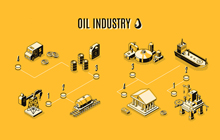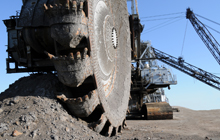OSFI’s new guidelines: A step toward making banks and insurers more conscious of their climate impacts

New sustainability reporting standards will help determine who will pay for environmental cleanup costs when oilsands producers go bankrupt
 |
Robert L. (Bob) Ascah is a research fellow at The Parkland Institute, University of Alberta. |
AFTER an extensive consultation process, the organization that supervises banks and large insurance companies in Canada — the Office of the Superintendent of Financial Institutions (OSFI) — has released guidelines for financial institutions to address climate change. This is timely, considering banks and insurers are massive funders of the fossil fuel industry.
The release of the guidelines, called the B-15, comes more than a year after a January 2022 pilot study by Canada’s central bank and OSFI on how resilient financial institutions would be under new climate policies.
The study found that the creditworthiness of oilsands producers is expected to fall over the next few decades. B-15 appears to address this concern by accommodating the needs of all stakeholders, including oilsands producers.
The development of B-15 is the result of one of the most ambitious consultations in OSFI history. It received nearly 4,400 submissions from financial institutions, non-regulated entities and other organizations and over 4,300 individuals.
But do the guidelines succeed in addressing the concerns of all stakeholders? And what, if anything, is missing?
Over the past 40 years, I have been involved in the formulation of financial sector policy, worked in a provincial financial institution and been a student of financial institution policy development. I have an appreciation for the role financial institutions play in modern economies and the importance of up-to-date policy frameworks and vigilant supervision.
Sustainability reporting
Sustainability reporting and environmental, social and governance investing have come under scrutiny recently, creating a surge in reporting standards ranging from industry-supported standards to third-party independent ones. These variations have made it difficult for analysts to understand how financial institutions are contributing to climate change.
The proliferation of reporting standards are making it virtually impossible for international bodies, like the United Nations or the Financial Stability Board, to meet public expectations about risks caused by greenhouse gas-emitting corporations.
To address this issue, international banks joined the UN-sponsored Net-Zero Banking Alliance in 2021. Members of the alliance have committed to aligning their loaning and investment activities with net-zero emissions by 2050.
This has led to the creation of rating agencies that inform investors about climate risks and the performance of financial institutions. A November 2022 report shed light on how poorly Canadian banks were progressing on their net-zero strategies.
Key takeaways from B-15
The OSFI wants more detailed summary information about financial markets and the governance of federally regulated financial institutions. The guidelines, which are quite general, emphasize objectivity, reliability and consistency of data reported. Here are the main takeaways:
1. Common definitions.Since federally regulated financial institutions are expected to understand climate-related risks and how to mitigate them, a common definition of climate risks is essential. The OSFI categorizes climate-related into two types of risks.
First, physical or operating risks include climate-related extremes and events, including mortality risks and physical risks. Second are transition risks, which include uncertainties about how climate-adjustment policies will unfold via government policies, legislation, greenhouse gas regulation, technological change and varying energy demands.
2. Climate-related disclosures.The guidelines outline principles for federally regulated financial institutions to disclose climate-related risks and opportunities. These principles include relevance, specificity, comprehensiveness, understandability, balance, reliability, consistency and verification. Companies should ensure disclosures meet certain principles and expectations without overwhelming users with unnecessary information.
3. Proportionality and materiality considerations.These terms refer to the fact that the guidelines are not one size fits all and largely depend on the size of financial institutions and their exposure to climate-related risks. Proportionality and materiality are necessary to understand the impact of catastrophic events, like a major breach from an oilsands tailings pond.
4. Adequate climate-related capital and liquidity requirements.Regulators believe climate-related risks have the potential to cause financial risk within institutions. Because of this, federally regulated financial institutions are expected to incorporate climate-related risks into capital adequacy and solvency assessments to prevent bank runs and insolvency.
Gaps in the guidelines
One of the gaps in the B-15 guidelines is that it fails to provide guidance on assessing pre-existing and future environmental liabilities.
For example, one of the most vexing issues for lenders to oilsands producers is assessing the longevity of reserves and whether borrowers’ assets will eventually become stranded, potentially forcing creditors to pay for environmental cleanups.
In the ground-breaking Redwater case, the Supreme Court of Canada ruled that, when oil companies go bankrupt, creditors are required to step in and clean up old oil and gas wells before any lenders are paid back. This is why Canadian lending institutions are so against putting these companies into bankruptcy.
At present, security posted by oilsands producers for future mine cleanup depends on how close oilsands mines are to the end of their reserve life. This determination is not as simple as it might appear.
Under the Alberta Mine Financial Security program, financial deposits are required to ensure any financial burden from abandonment and reclamation remains with the energy companies that own them.
At present, there is $1.55 billion in security held for liabilities estimated by the Alberta Energy Regulator to total $33.7 billion, a number that critics believe is seriously underestimated.
However, under the regulator’s rules, an oilsands producer is only required to post an operating deposit when there are less than 15 years of reserves remaining. So long as the reserves are provable, climate change policies, environmental liabilities and economic viability appear irrelevant to the Alberta Energy Regulator.
This is highly problematic in the current climate of mistrust that has arisen from the behaviour of the Alberta Energy Regulator concerning a large toxic spill at the Imperial Kearl Lake tailings ponds. The provincial regulator waited months to publicly disclose that waste was escaping from the pond and seeping into groundwater.
A second gap is the issue of third-party verification of institutions’ reporting. The current guideline does not require this, leaving it up to the institutions to handle themselves.
A step in the right direction
The total credit exposure of Canadian banks is estimated to be $164 billion — less than 15 per cent of Canada’s five biggest banks’ capital.
That said, the disclosure practices of fossil fuel producers on decommissioning environmental liabilities is opaque and inconsistent.
Should the banks inherit stranded assets, not only will they have to write off their investments, but depending on the legal regime, they may be exposed to enormous additional costs of cleaning up tailings ponds. Otherwise, this bill may fall to taxpaying Canadians.
OSFI’s guidelines are a small step towards making financial decision-makers more conscious of the influence they have on climate outcomes, but there is still work to be done when it comes to climate-risk policies.
Robert L. Ascah is a research fellow at The Parkland Institute at the University of Alberta. Read the original article with full hyperlinks on The Conversation (Canada). Author phot: The Conversation (Canada)










(0) Comments